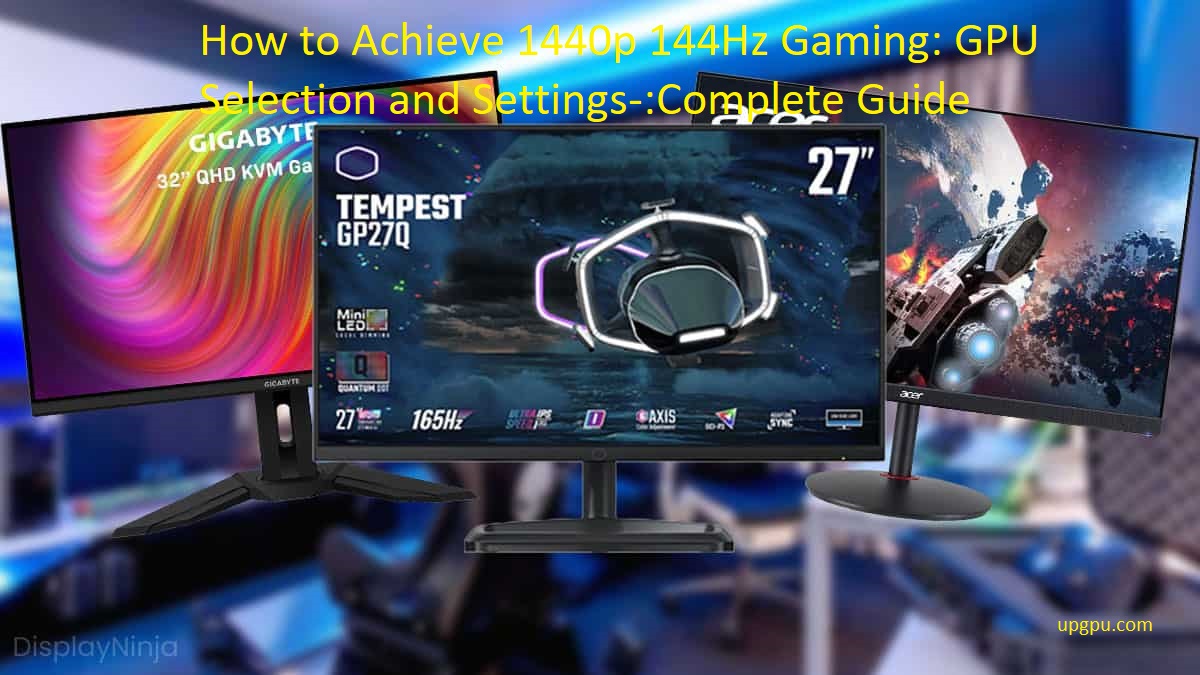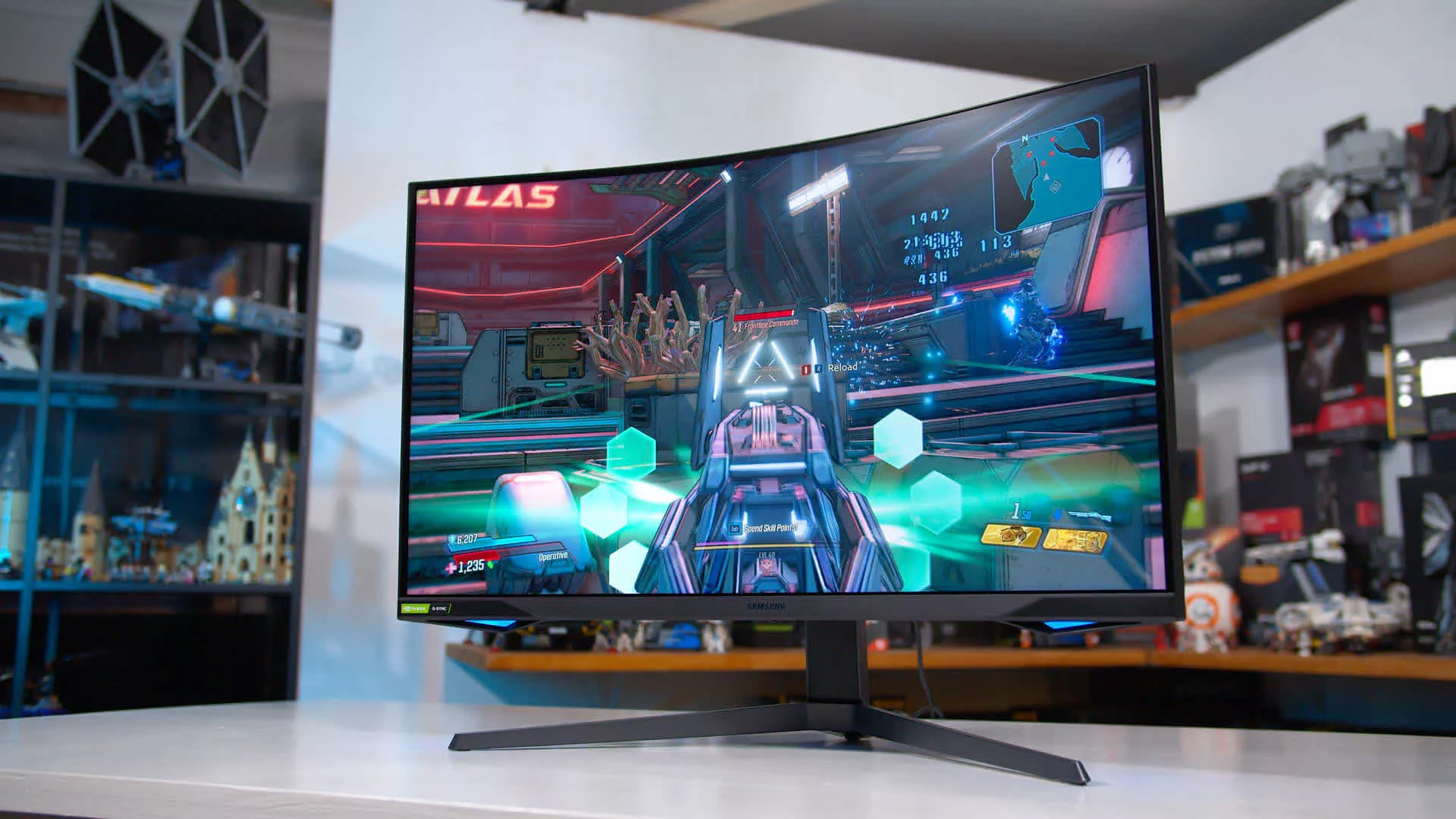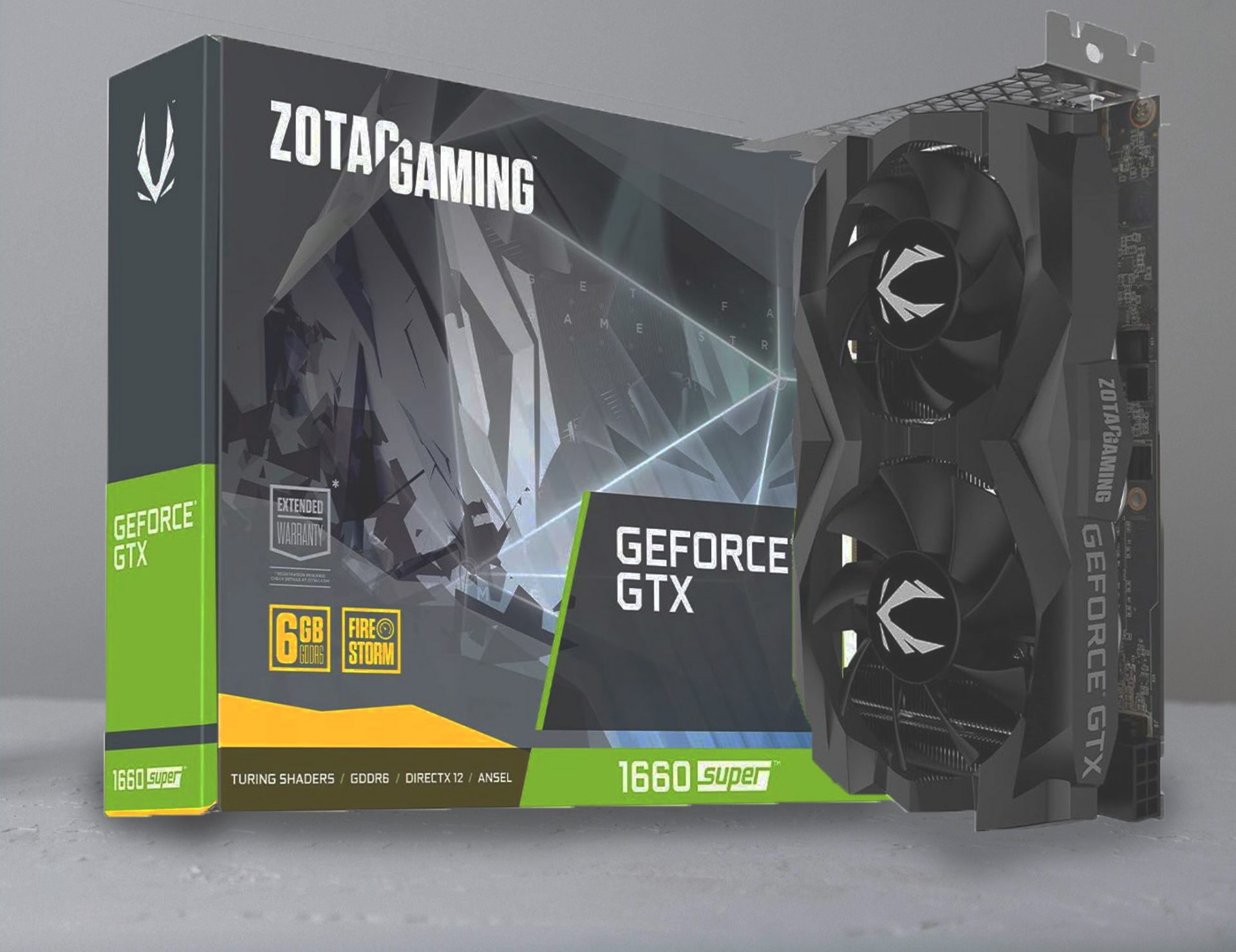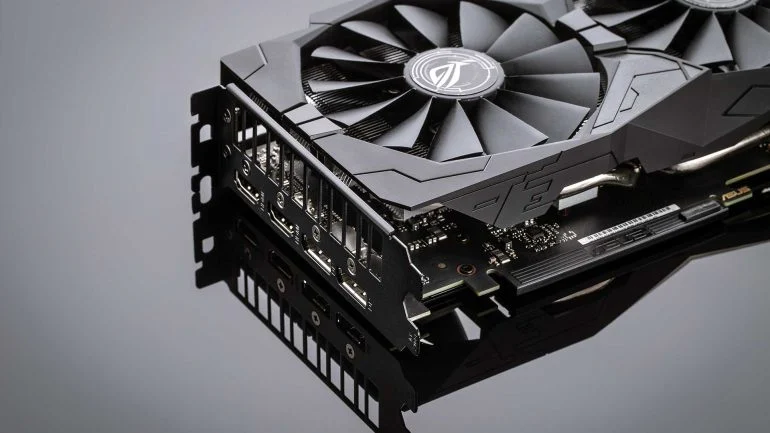Are you a PC gamer looking to break into 1440p 144Hz gaming? You’ve come to the right spot!
With this guide, we’ll cover everything from graphics card selection and optimization to settings for an ultra-smooth, fast performance. Get ready for an immersive gaming experience!
The world of gaming is rapidly evolving, and this guide will provide the information needed to achieve a 1440p 144Hz gaming experience. Over the last few years, gamers have seen graphic cards become more powerful and capable of higher resolutions and framerates. With higher resolutions come more available pixels, allowing for improved image quality and detail.
At 1440p 144Hz, images are sharper, better defined, and far superior to a traditional 1080p resolution. Combined with the smoothness of a 144Hz refresh rate monitor, you’re treating yourself to an unprecedented gaming experience. In order to take full advantage of these advanced technologies, you’ll need to select the right GPU as well as setup your graphics settings correctly. This guide will give an overview of the necessary components for hitting 1440p 144Hz, discuss how GPUs handle performance demands at this resolution/FPS combination, examine graphics settings that can be adjusted for optimizing performance and image quality on those titles that don’t perform well at144fps@1440p naturally.

Explanation of 1440p 144Hz gaming
1440p 144Hz gaming is an increasingly popular setup among PC gamers, thanks to the support of resolutions and refresh rates by modern-day graphics cards and displays. For those who are new to this kind of gaming, it can be confusing as there is a lot to consider when choosing a GPU and configuring settings for 1440p 144Hz play.
The goal of 1440p 144Hz gaming is to achieve high frame rates (144 frames per second in this case) for a 720p display with a 16:9 aspect ratio. Display refresh rate plays an important role in one’s playing experience when using multiple graphics cards in tandem. To reach the desired level of performance in 1440p games, an appropriate choice of GPU and configuration are essential.
A modern graphics card should be able to easily deliver 1440p gameplay with medium-high graphical settings; however, if you’re looking for higher frame rates for competitive or professional use, then you will likely require more powerful GPUs or computational resources like SLI/CrossFire or overclocking options.
Benefits of achieving 1440p 144Hz gaming
Achieving 1440p 144Hz gaming provides several benefits to the user. Foremost among these is the improved performance that comes with higher resolutions and higher frames per second (FPS). This can make a significant difference during more intense gaming sessions, where having a smoother image and faster responsiveness can give you an advantage over competing gamers.
In addition, this setup can also provide an improved viewing experience, as the additional resolution offered by 1440P allows for significantly more detail to be seen and experienced during play. Many popular titles are programmed with extra details or effects that are only visible when played on monitors with 1440P capabilities. And for streamers who need to record in higher resolution for better quality footage, 1440P 144Hz gaming will ensure that no details are missed.
Finally, achieving this level of performance is also great for users who regularly multitask while playing games — something which will be necessary in highly competitive environments like e-sports tournaments or LAN parties. With up to 144 refresh rates available per second, users have the potential to switch between multiple applications quickly and efficiently with minimal lag time between screens or tasks.
GPU Selection

Selecting the right GPU is essential for achieving 1440p 144Hz gaming. When it comes to graphics card selection, there are two main considerations: cost and performance. Cost-to-performance ratio is always an important factor to consider when selecting a GPU, as it can help determine your overall budget. Performance should be at the top of your list, however, because compromises in terms of cost may limit or inhibit the effect that a more expensive GPU could provide.
To achieve 1440p 144Hz gaming, you will need a graphics card with enough power to reach that particular resolution and refresh rate. Doing so requires a powerful GPU capable of running games on higher settings at 60+ frames per second (FPS). Factors that play a significant role in determining the necessary performance requirements include graphical settings such as AntiAliasing (AA), Texture Quality and Shadow Quality; Engine Settings such as Resolution Scale and Anisotropic Filtering; and Graphics APIs such as DirectX 11/12 or Vulkan.
The most optimal way to select a GPU for 1440p 144Hz gaming is to look at benchmarks from various review sites that compare different GPUs on specific games with different configurations at various resolutions and refresh rates. This will allow you to determine which GPUs are able to hit 60 FPS or higher on your desired games while playing in 1440p 144 Hz. It’s also important to take into account technological advancements like Ray Tracing when selecting GPUs since this can significantly impact game visuals and performance dependending on how much you turn on the effects in supported titles.
Overview of different GPU options
When it comes to delivering the most immersive gaming experience, having the right graphics card is essential. Depending on what GPU you have and the current settings, achieving high resolutions with fast refresh rate may not be possible. To break down exactly what you need for 1440p 144Hz gaming in 2021, here is an overview of different GPU options and settings that can help you make the best decision possible.
The most important factor when shopping for a graphics card is power, measured in TFLOPS (tera-floating point operations per second). The higher the number of TFLOPS your GPU offers, the more power you’ll have to process high resolutions with frame rates up to 144Hz or higher. A typical gaming PC will require at least an 8-10 TFLOPs graphics card for 1440p 144Hz performance. For example, an NVIDIA GeForce RTX 3080 has a 10TFLOPs rating, while AMD’s Radeon RX 6800 XT has a 16TFLOPs rating.
Apart from this, other factors like memory speed/video memory size are also important when it comes to selecting a GPU. Typical video RAM sizes range from 8GB to 16GB; more RAM means better textures and faster read/write times can help reduce system latency issues caused by swapping of tiles between VRAM and RAM. Memory speed also matters; look for GDDR6 or faster levels when shopping around for GPUs intended for 1440p 144Hz performance.
Factors to consider when selecting a GPU

When selecting a GPU for an 1440p 144Hz gaming setup, it’s important to consider several factors. The model of the GPU, its core clock speeds and the cooling mechanisms are key elements in determining its suitability.
The model of GPU is important as each model offers different levels of performance and efficiency. This includes looking at factors such as the number of cores on the card, and whether it comes with high-end features like real-time ray tracing technology. The performance can also be affected by Memory Clock speeds; higher memory clock speeds mean faster memory read/write speeds which translates to better overall performance in games.
It is also important to pay attention to cooling mechanisms on a graphics card, such as dual or triple fans on GPUs or GeForce technologies like Active Fan Control and NVIDIA WhisperMode that reduce fan noise and maintain optimal temperatures for increased gaming performance, even during intensive gaming sessions. Additionally, it’s vital to look at the power requirements for a GPU so that you can get a suitable power supply unit that can provide enough wattage for the card.
Budget
When it comes to purchasing a GPU for gaming, budget is an important factor to consider. If you are looking for smooth gaming performance in 1440p 144Hz, you will need a graphics card with high specifications and advanced features.
The budget also depends on the types of games you plan on playing as some titles require high-end GPUs while others may run well with an entry-level graphics card. Some of the variables that can affect the cost include resolution and display refresh rate, GPU core clock speed, number of cores or processor threads, video memory size and type, shader model or horsepower rating, software compatibility, brand preference and more.
Once you’ve set your budget range and determined what type of games you want to play, it’s time to narrow down your choices.
Power consumption

When choosing a GPU for 1440p 144Hz gaming, it is important to take into account the power consumption of the card. This is especially true if you are powering a large gaming rig with multiple monitors and/or other components that require additional power.
Generally speaking, higher-end cards will use more power when running at high settings and resolutions. However, it is important to understand the power consumption between different models of the same card to determine which card is right for your particular build and application.
Most current graphics cards list their maximum power consumption on their spec sheets, making it easy to compare models based on their actual specifications. Be sure to take into account your particular system’s total estimated power draw when determining what size of a power supply you need in order to run your system efficiently and safely.
GPU Settings
Once you’ve selected the right GPU to enable smooth 1440p 144 Hz gaming, it is important to make sure your settings are correctly optimized. GPU drivers are constantly upgraded and its important to keep them up-to-date as they often include performance improvements, bug fixes, and optimizations for new games. Additionally, most GPUs feature control panels that can be used to tweak settings in order to achieve decent gaming performance while keeping video quality intact.
Common settings you may want to adjust include Anti-Aliasing (AA), Anisotropic Filtering (AF), Vertical Synchronization (VSync), Ambient Occlusion (AO), Texture Filtering Quality, and more. AA improves the quality of flat surfaces by smoothing out jagged edges; AF reduces aliasing on textures seen from far distances; VSync prevents screen tearing; AO adds more realistic shadows; and Texture Filtering Quality helps improve texture clarity when viewed from a distance or up close.
In some cases, depending on your GPU model, you may also have the ability to adjust clock speeds or overclock the card specifically for gaming activities. Overclocking can increase the performance of your graphics card while trading off some level of extra heat production which is why it’s important to take into account when selecting a case and cooling solution for your gaming PC.
Overview of important GPU settings
For the best results when gaming at 1440p 144Hz, it is important to understand the GPU settings that affect your performance. To maximize your gaming experience, it is essential to be aware of how each setting interacts with the other options and what kinds of impacts they can have on your in-game performance.
GPU settings play a pivotal role in how your graphics card interacts with the game and the monitor, especially when using 144Hz displays. Ultimately, these settings will determine whether or not you’re able to reach those frame rates at 1440p resolution that make for smooth gameplay. Below is an overview of some of the main GPU settings you should be familiar with for optimal performance:
MSI Afterburner Settings: MSI afterburner is a freely available software suite for overclocking and monitoring GPU performance. This can provide significant gains in terms of frame rate but may require tinkering with some configuration options to get there. It includes clock speed adjustment, fan speed adjustment, voltage adjustment as well as several other features that can help boost performance by increasing overall system stability.
V-Sync Technology: V-Sync (short for Vertical Synchronization) reduces screen tearing by synchronizing your game’s frames per second (FPS) with the refresh rate of your monitor’s display technology. This helps ensure smoother graphics performance, eliminating choppiness or slowdown during intense moments in gameplay. Some graphics cards now come equipped V-Sync technology built right in though often times it’s recommended to disable it unless you are experiencing problems such as screen tearing while playing games at higher resolutions such as 1440p 144hz.
Supersampling: Supersampling uses Powerful GPUs to make images much sharper than could normally be accomplished on a regular resolution display by increasing sub pixel sample size by 2 or 4 times which results in much finer detail due to additional anti aliasing being applied to rendered objects within games scenes making them appear much smoother and less jagged or aliased textured when available should always Be Enabled. This helps remove visual artifacts from low frame rate scenarios aiding significantly when attempting high refresh rates such has 144 fps at increased resolution 1440p.
How to optimize GPU settings for 1440p 144Hz gaming
Now that you’ve selected your GPU, it’s time to optimize the settings to get the most out of your gaming experience. These settings will allow for maximum performance without freezing or dropping frames.
First, set the resolution to 1440p (2560 × 1440) in order to make full use of the potential of your GPU. This will give you a sharper image than Full HD (1080p) and will make your games look incredible.
Next, you need to set the refresh rate in your display settings. Most 144Hz gaming monitors come with a factory setting of 120Hz, so be sure to set yours up at 144Hz for an entirely smooth gaming experience. Some people prefer 120Hz because this can save them up to 15 frames per second on some games; however by setting higher refresh rates like 144 or even 160 Hz can bring a new level of vibrancy and smoothness amongst gamers when playing At 4K resolutions.
You may also need to adjust anti-aliasing and motion blur if needed. Anti-aliasing is responsible for smoothing out sharp edges in picture quality, while motion blur makes fast moving images appear blurry by blurring areas that move quickly between frames onscreen. Both these effects can have an impact on game performance so try tweaking them if you find that your games are running too slowly or not looking as good as they should at 1440p resolution and 144Hz refresh rate at high graphical settings.
Finally it is important to monitor temperatures through software like “MSI Afterburner” which lets you check GPU temps in real time while playing games at maximum graphical settings – ultimately this helps prevent any possible overheating damages due to continuous usage or extremely high torque runs!
Refresh rate
Refresh rate is the number of times in one second that your monitor refreshes image. A higher refresh rate translates to smoother on screen motion and images.
Generally speaking, users should look for a monitor with at least a 144Hz refresh rate in order to get an optimum gaming experience. When it comes to a 144Hz 1440p monitor the best result would be achieved when connected with a mid- range graphics card or higher such as Nvidia GTX 1060 or AMD Radeon RX 580 and turn off any settings such as anti- aliasing, v-sync or motion blur to achieve optimal performance for the highest refresh rates available.
However, those with mid-level GPU cards should make sure that Settings are kept on lowest or removed completely to ensure best performance. Additionally, gamers may also need to consider overclocking their graphics cards speed in order obtain maximum output out of them.
Resolution
When choosing a resolution for gaming, the number of monitors you plan to connect together and your desired refresh rate should be taken into consideration. Depending on the graphics cards in your PC, a higher resolution will require greater GPU power.
For gaming at 1440p 144Hz or 120Hz, you need to pick one of the high-end graphics cards in Nvidia’s RTX lineup or AMD’s Radeon RX 5000 series. Your choice of processor should match or exceed Intel’s 9th Gen Core i7 or AMD Ryzen 7 processors if you are going for high settings with a fast refresh rate. However, if 1080p is enough and 144Hz is your main objective, then an Intel Core i5 processor or AMD Ryzen 5 CPU will suffice in most cases. For an even more budget option, an AMD Ryzen 3 processor paired with a GTX 1650 can deal with 1440p 60fps gaming.
It stands to reason that if you have enough GPU power available and don’t mind spending more money on extra monitors for increased viewing angles, then multi-monitor set-ups can be great for competitive esports gamers as well as providing extra desktop space when needed. Most GPUs have enough headroom left to run games at higher settings and higher resolutions when running across multiple displays at once – although this also depends on how demanding a game’s graphical effects are and their display settings options in addition to the hardware powering it all up!
Conclusion
Overall, in order to achieve 1440p 144Hz gaming, selecting the right GPU is essential. There are many different models available on the market – and as a result, gamers may find it difficult to make a decision. Make sure to consider factors such as price point and budget, thermal performance, and other additional features such as ray tracing or G-Sync/FreeSync capabilities.
Once you have chosen your new graphics card, you can apply the recommended settings from your graphics card manufacturer to get the best performance out of your GPU. With this in mind, your search for achieving 1440p 144Hz gaming should be much simpler – allowing you to finally enjoy ultra-smooth gaming experiences with visuals that truly bring games to life!
FAQs
What is the ideal GPU for 1440p 144Hz?
The ideal GPU for 1440p 144Hz gaming would be the NVIDIA GeForce RTX 3080 or the AMD Radeon RX 6800 XT.
What is the best GPU for 1440p gaming ultra settings?
The best GPU for 1440p gaming at ultra settings would be the NVIDIA GeForce RTX 3080 or the AMD Radeon RX 6800 XT.
How much RAM do I need for 1440p 144Hz gaming?
For 1440p 144Hz gaming, 16GB of RAM is sufficient.
Is RTX 3080 enough for 1440p 144Hz?
Yes, the RTX 3080 is more than enough for 1440p 144Hz gaming and can handle most games at high to ultra settings.
Can RTX 3060 play 1440p 144Hz?
The RTX 3060 can play games at 1440p, but it may struggle to maintain a consistent 144Hz frame rate on higher settings in more demanding games.
How much GPU RAM do I need for 1440p?
For 1440p gaming, 6GB to 8GB of GPU RAM is usually sufficient, although some more demanding games may require 8GB or more.
Is 1440p more GPU or CPU intensive?
1440p gaming is generally more GPU intensive than CPU intensive, as the GPU is responsible for rendering the images and textures on the screen.
Is RTX 3080 better than 3070 for 1440p 144Hz?
The RTX 3080 is generally better than the RTX 3070 for 1440p 144Hz gaming, as it can handle higher frame rates on higher settings in more demanding games.
What GPU do I need for a 144Hz monitor?
For a 144Hz monitor, a high-end GPU such as the NVIDIA GeForce RTX 3080 or AMD Radeon RX 6800 XT is recommended for optimal performance.
How many cores for 1440p gaming?
Most games do not require more than six CPU cores for 1440p gaming, although some newer games may benefit from additional cores.
See More
- Hello world!
- Best gpu for ryzen 9 3950x 2023
- Best 1080p 144Hz GPU 2023
- Best GPU for Ryzen 9 5900x 2023
- Best 3080 GPU 2023

